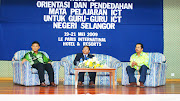| | |
The Framework presents a holistic view of 21st century teaching and learning that combines a discrete focus on 21st century student outcomes (a blending of specific skills, content knowledge, expertise and literacies) with innovative support systems to help students master the multi-dimensional abilities required of them in the 21st century.
The key elements of 21st century learning are represented in the graphic and descriptions below. The graphic represents both 21st century skills student outcomes (as represented by the arches of the rainbow) and 21st century skills support systems (as represented by the pools at the bottom).
While the graphic represents each element distinctly for descriptive purposes, the Partnership views all the components as fully interconnected in the process of 21st century teaching and learning.
The elements described below are the critical systems necessary to ensure 21st century readiness for every student. Twenty-first century standards, assessments, curriculum, instruction, professional development and learning environments must be aligned to produce a support system that produces 21st century outcomes for today’s students.
Twenty-First Century Student Outcomes and Support Systems
- Download a brief PDF version of the Framework here.
- Download the full P21 Framework Definitions document.
- Visit Route 21 for an interactive view of the framework here.
Twenty-First Century Student Outcomes
The elements described in this section as “21st century student outcomes” (represented by the rainbow) are the skills, knowledge and expertise students should master to succeed in work and life in the 21st century.
1. Core Subjects and 21st Century Themes
2. Learning and Innovation Skills
3. Information, Media and Technology Skills
Twenty-First Century Support Systems
The elements described below are the critical systems necessary to ensure student mastery of 21st century skills. 21st century standards, assessments, curriculum, instruction, professional development and learning environments must be aligned to produce a support system that produces 21st century outcomes for today’s students.
1. Twenty-First Century Standards
2. Assessment of 21st Century Skills
3. Twenty-First Century Curriculum and Instruction
4. Twenty-First Century Professional Development
5. Twenty-First Century Learning Environments
Please visit this site for more info











0 comments:
Post a Comment